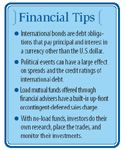Article
International bonds offer greater diversification
International bonds, also referred to as non-dollar bonds, are debt obligations that pay principal and interest in a currency other than the U.S. dollar.

Key Points

A International bonds, also referred to as non-dollar bonds, are debt obligations that pay principal and interest in a currency other than the U.S. dollar. International bonds can potentially bring increased diversification to fixed-income portfolios, along with the opportunity for higher yield and enhanced returns.
Just as investors look to international equities for exposure to foreign markets not perfectly correlated to U.S. stock markets, the same concept applies to foreign debt. Their principal value may be determined by factors such as balance of payments, relative interest rates overseas, and commodity prices. If the economic environment in a foreign country is improving, credit upgrades and the tightening of yield spreads can result in international bonds outperforming similar quality domestic bonds.
Many investors, however, overlook an important distinction when researching international bond investments: the difference between country and currency exposure. For example, the Yankee bond is an investment-grade bond whose issuer is domiciled outside of the United States, but the bond is denominated in U.S. dollars and traded in the U.S. bond market.

Many investors like the advantage of professional management associated with investing in international bonds within a mutual fund platform. Bond managers can use their skill in predicting exchange rate movements and can purchase foreign denominated bonds to gain exposure to these currencies. Keep in mind that simply being exposed to foreign currencies and foreign yield curves results in an added element of diversification.
Bond managers often attempt to minimize the risk or increase potential return by hedging currency risk. Financial futures contracts can be used in an attempt to remove the foreign currency exposure of the bonds. Using currency futures contracts allows that manager to avoid changes in the value of the foreign currency relative to the U.S. dollar.
Given the relatively low interest rate environment in the United States, international bonds may offer an opportunity for investors to add value to a fixed-income bond portfolio. Understanding the difference between country and currency exposure and techniques to manage them can only help the investor in making intelligent and prudent investment decisions. International fixed-income investing can entail additional risk in the form of underlying currency devaluation, decreasing liquidity, and regulatory and default risks associated with political events. Be sure that you understand these risks prior to making any investment.
Q I'm confused about the difference between load funds and no-load funds. Is it true that I do not have to pay any expenses with no-load funds?
A In myriad variables that must be evaluated before selecting a mutual fund, perhaps the most misunderstood is total fund costs and how these costs relate to fund returns.





